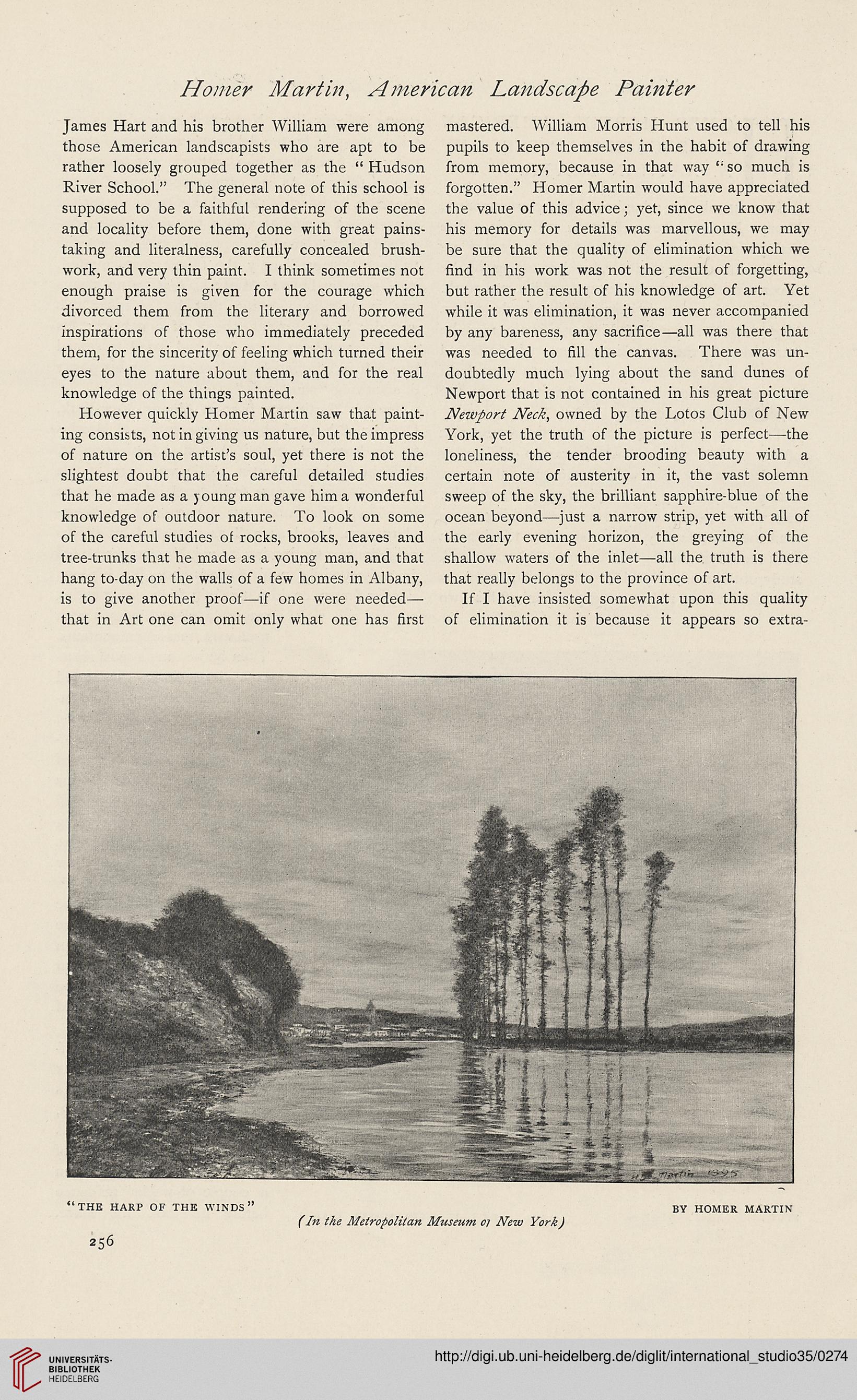Homer Martin, American Landscape Painter
James Hart and his brother William were among
those American landscapists who are apt to be
rather loosely grouped together as the “ Hudson
River School.” The general note of this school is
supposed to be a faithful rendering of the scene
and locality before them, done with great pains-
taking and literalness, carefully concealed brush-
work, and very thin paint. I think sometimes not
enough praise is given for the courage which
divorced them from the literary and borrowed
inspirations of those who immediately preceded
them, for the sincerity of feeling which turned their
eyes to the nature about them, and for the real
knowledge of the things painted.
However quickly Homer Martin saw that paint-
ing consists, not in giving us nature, but the impress
of nature on the artist’s soul, yet there is not the
slightest doubt that the careful detailed studies
that he made as a young man gave him a wonderful
knowledge of outdoor nature. To look on some
of the careful studies ol rocks, brooks, leaves and
tree-trunks that he made as a young man, and that
hang to-day on the walls of a few homes in Albany,
is to give another proof—if one were needed—
that in Art one can omit only what one has first
mastered. William Morris Hunt used to tell his
pupils to keep themselves in the habit of drawing
from memory, because in that way “ so much is
forgotten.” Homer Martin would have appreciated
the value of this advice; yet, since we know that
his memory for details was marvellous, we may
be sure that the quality of elimination which we
find in his work was not the result of forgetting,
but rather the result of his knowledge of art. Yet
while it was elimination, it was never accompanied
by any bareness, any sacrifice—all was there that
was needed to fill the canvas. There was un-
doubtedly much lying about the sand dunes of
Newport that is not contained in his great picture
Newport Neck, owned by the Lotos Club of New
York, yet the truth of the picture is perfect—the
loneliness, the tender brooding beauty with a
certain note of austerity in it, the vast solemn
sweep of the sky, the brilliant sapphire-blue of the
ocean beyond—just a narrow strip, yet with all of
the early evening horizon, the greying of the
shallow waters of the inlet—all the truth is there
that really belongs to the province of art.
If I have insisted somewhat upon this quality
of elimination it is because it appears so extra-
256
(In the Metropolitan Museum 0/ New York)
James Hart and his brother William were among
those American landscapists who are apt to be
rather loosely grouped together as the “ Hudson
River School.” The general note of this school is
supposed to be a faithful rendering of the scene
and locality before them, done with great pains-
taking and literalness, carefully concealed brush-
work, and very thin paint. I think sometimes not
enough praise is given for the courage which
divorced them from the literary and borrowed
inspirations of those who immediately preceded
them, for the sincerity of feeling which turned their
eyes to the nature about them, and for the real
knowledge of the things painted.
However quickly Homer Martin saw that paint-
ing consists, not in giving us nature, but the impress
of nature on the artist’s soul, yet there is not the
slightest doubt that the careful detailed studies
that he made as a young man gave him a wonderful
knowledge of outdoor nature. To look on some
of the careful studies ol rocks, brooks, leaves and
tree-trunks that he made as a young man, and that
hang to-day on the walls of a few homes in Albany,
is to give another proof—if one were needed—
that in Art one can omit only what one has first
mastered. William Morris Hunt used to tell his
pupils to keep themselves in the habit of drawing
from memory, because in that way “ so much is
forgotten.” Homer Martin would have appreciated
the value of this advice; yet, since we know that
his memory for details was marvellous, we may
be sure that the quality of elimination which we
find in his work was not the result of forgetting,
but rather the result of his knowledge of art. Yet
while it was elimination, it was never accompanied
by any bareness, any sacrifice—all was there that
was needed to fill the canvas. There was un-
doubtedly much lying about the sand dunes of
Newport that is not contained in his great picture
Newport Neck, owned by the Lotos Club of New
York, yet the truth of the picture is perfect—the
loneliness, the tender brooding beauty with a
certain note of austerity in it, the vast solemn
sweep of the sky, the brilliant sapphire-blue of the
ocean beyond—just a narrow strip, yet with all of
the early evening horizon, the greying of the
shallow waters of the inlet—all the truth is there
that really belongs to the province of art.
If I have insisted somewhat upon this quality
of elimination it is because it appears so extra-
256
(In the Metropolitan Museum 0/ New York)




